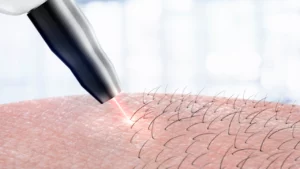What are ovarian cysts?
Ovarian cyst is being described as “fluid-filled sacs or pockets in an ovary or on its surface.” These cysts can develop at any given point in a woman’s life. While not all cysts are harmful—some even vanish by themselves after a few months—if a cyst does rupture, it can have serious consequences.
About ovaries
Women have two ovaries on both sides of their uterus that produce the estrogen and progesterone hormones along with eggs. Every month, as part of your menstrual cycle, eggs develop and grow in these ovaries and are released. When an egg fertilises, it leads to a pregnancy. Your uterus’ lining is what releases during your period along with blood and can also include remains of the egg that was released before your period and not fertilised.
Symptoms of ovarian disorders
Even though all cysts are not of a harmful nature, the ones that are can cause discomfort, making it essential to get medical attention. If you find yourself experiencing the following symptoms or any sort of abdominal discomfort, it’s worth getting it checked out. Common symptoms of cysts include:
- Lower abdomen pain or cramps, especially if they occur when your period isn’t around the corner, can be signifiers of ovarian cysts
- Excessive bloating that never seems to go away could mean that it needs additional attention.
- If your stomach constantly feels heavy without any dietary changes, it could be the sign of a cyst.
- If you seem to experience sudden, excruciating pain during vaginal sexual intercourse, you should get yourself checked to rule out the possibility of a cyst.
- Symptoms associated with your menstrual cycle like pain in your thighs or lower back, nausea, or tender breasts can also worsen when you’re dealing with a cyst.
It is recommended that you see a doctor as soon as possible if you’re experiencing the symptoms mentioned above.
Diagnosis
Your diagnosis by a gynaecologist will include an initial consultation wherein they will ask you about your lifestyle, general health conditions and about the symptoms you’re feeling. They will also most likely do a physical examination by checking your lower abdomen for any excess growth that they may be able to feel on the outside. If they do believe there is a cystic formation, they will ask you to go in for a pelvic scan or sonography to further put together a diagnosis.
Ruptured ovarian cysts
Cysts become a cause of concern when they become large in size, rupture or cause your ovary to move from its original position.
Healthline suggests the following symptoms that can indicate a ruptured cyst:
- severe or sharp pelvic pain
- fever
- faintness or dizziness
- rapid breathing
Ruptured cysts can cause internal bleeding which can lead to an infection and further complications if not tended to in time. Regular pelvic examinations and keeping a note of your bodily symptoms can help avoid this.
Causes
The following excerpt by Mayo Clinic describes the most common causes of cysts.
“Most ovarian cysts develop as a result of your menstrual cycle (functional cysts). Other types of cysts are much less common.
Functional cysts
Your ovaries normally grow cyst-like structures called follicles each month. Follicles produce the hormones estrogen and progesterone and release an egg when you ovulate.
If a normal monthly follicle keeps growing, it’s known as a functional cyst. There are two types of functional cysts:
- Follicular cyst: Around the midpoint of your menstrual cycle, an egg bursts out of its follicle and travels down the fallopian tube. A follicular cyst begins when the follicle doesn’t rupture or release its egg, but continues to grow.
- Corpus luteum cyst: When a follicle releases its egg, it begins producing estrogen and progesterone for conception. This follicle is now called the corpus luteum. Sometimes, fluid accumulates inside the follicle, causing the corpus luteum to grow into a cyst.
Functional cysts are usually harmless, rarely cause pain, and often disappear on their own within two or three menstrual cycles.
Other cysts
Types of cysts not related to the normal function of your menstrual cycle include:
- Dermoid cysts: Also called teratomas, these can contain tissue, such as hair, skin or teeth, because they form from embryonic cells. They’re rarely cancerous.
- Cystadenomas: These develop on the surface of an ovary and might be filled with a watery or a mucous material.
- Endometriomas: These develop as a result of a condition in which uterine endometrial cells grow outside your uterus (endometriosis). Some of the tissue can attach to your ovary and form a growth.
Dermoid cysts and cystadenomas can become large, causing the ovary to move out of position. This increases the chance of painful twisting of your ovary, called ovarian torsion. Ovarian torsion may also result in decreasing or stopping blood flow to the ovary.”
Risk factors
Certain bodily functions and health concerns can increase the chances of you developing cysts. Some of the most common ones include:
- Pregnancy
- Hormonal conditions
- Ovarian cysts you’ve dealt with in the past
- Infection around the ovaries
- Endometriosis
Treatment
Since not all cysts are dangerous and most subside by themselves, it’s not necessary that your doctor will recommend a medical procedure to treat them. They may recommend waiting it out and getting another ultrasound in a few weeks to understand if you need further treatment. If the cyst does not show signs of subsidising, your doctor will then recommend a treatment plan for the same. The treatments for ovarian cysts include:
- A Laparoscopy which involves making a small incision around the area to remove the cyst.
- If your cysts seem to recur every few months, your doctor may recommend getting on birth control pills to stop them from developing.
- A Laparotomy takes place if your cyst is very large and needs to be surgically removed.
- If your cyst is cancerous, your doctor will perform a hysterectomy to remove your uterus and ovaries.
Can ovarian cysts cause cancer?
While most ovarian cysts are harmless, if they occur after menopause, they can be malignant in nature and have a risk of cancer associated with them. Having regular pelvic check-ups can help rule out any such health complications.
Complications
Ovarian cysts can have certain complications associated with them if they are too large in size, don’t naturally subside or rupture in the process. Mayo Clinic explains these complications below:
- Ovarian torsion: Cysts that enlarge can cause the ovary to move, increasing the chance of painful twisting of your ovary (ovarian torsion). Symptoms can include an abrupt onset of severe pelvic pain, nausea and vomiting. Ovarian torsion can also decrease or stop blood flow to the ovaries.
- Rupture: A cyst that ruptures can cause severe pain and internal bleeding. The larger the cyst, the greater the risk of rupture. Vigorous activity that affects the pelvis, such as vaginal intercourse, also increases the risk.
Prevention
Due to their erratic and sudden nature, there aren’t too many ways to avoid ovarian cysts. However, you can manage them by diagnosing them at an early stage by taking note of your menstrual cycle, ensuring that your menstrual symptoms are the same as always, noticing any other physical changes, especially around the abdominal area that seem out of the ordinary, and getting regular pelvic exams.







